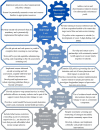Equitable suicide prevention for youth impacted by the juvenile legal system
- PMID: 36387003
- PMCID: PMC9640731
- DOI: 10.3389/fpsyt.2022.994514
Equitable suicide prevention for youth impacted by the juvenile legal system
Abstract
Suicide is the second leading cause of death for adolescents in the United States. Despite the already alarmingly high rates of suicide attempts among adolescents, youth involved in the juvenile legal system (JLS) are up to three times more likely to have suicide attempts than their peers not impacted by the JLS. This public health crisis is also a matter of health equity, knowing that ethnoracially minoritized youth, mainly Black and Latinx youth, have disproportionate contact with the JLS. In order to disrupt the current elevated rates of suicide among Black and Latinx youth involved in the JLS, there needs to be more concerted efforts to improve assessment and suicide prevention efforts in the JLS. There are various potential touch points of care for suicide prevention and the Sequential Intercept Model (SIM), which outlines community-based responses to the involvement of people with mental and substance use disorders in the criminal justice system, can be used as a strategic planning tool to outline possible equitable interventions across these various touch points. Our purpose is to provide a comprehensive picture of gaps and equitable opportunities for suicide prevention across each intercept of the SIM. We provide recommendations of priorities to promote health equity in suicide prevention for ethnoracially minoritized youth impacted by the JLS.
Keywords: Sequential Intercept Model; adolescents; equity; ethnoracially minoritized youth; juvenile legal system; suicide; suicide prevention and intervention.
Copyright © 2022 Meza, Snyder and Shanholtz.
Conflict of interest statement
The authors declare that the research was conducted in the absence of any commercial or financial relationships that could be construed as a potential conflict of interest.
Figures
Similar articles
-
Informing Equitable Prevention Practices: A Statewide Disaggregated Analysis of Suicide for Ethnoracially Minoritized Adolescents.Prev Sci. 2024 Apr;25(3):532-544. doi: 10.1007/s11121-024-01654-1. Epub 2024 Mar 2. Prev Sci. 2024. PMID: 38429617 Free PMC article.
-
Identifying Gaps in Mental Health Service and Supports Utilization among Minoritized Youth with Mental Health Concerns in the Juvenile Legal System.Child Youth Serv Rev. 2025 Apr;171:108176. doi: 10.1016/j.childyouth.2025.108176. Epub 2025 Feb 12. Child Youth Serv Rev. 2025. PMID: 40248496
-
Structural Racism and Suicide Prevention for Ethnoracially Minoritized Youth: A Conceptual Framework and Illustration Across Systems.Am J Psychiatry. 2022 Jun;179(6):422-433. doi: 10.1176/appi.ajp.21101001. Am J Psychiatry. 2022. PMID: 35599542 Free PMC article. Review.
-
Youth with Behavioral Health Symptoms in the Juvenile Legal System: From Assessment of Needs to Interventions to Scalability.Annu Rev Clin Psychol. 2025 May;21(1):327-352. doi: 10.1146/annurev-clinpsy-081423-021503. Epub 2025 Feb 10. Annu Rev Clin Psychol. 2025. PMID: 39929548 Review.
-
From court to the community: improving access to evidence-based treatment for underserved youth involved in the juvenile legal system at-risk for suicide.BMC Psychiatry. 2023 May 5;23(1):320. doi: 10.1186/s12888-023-04824-7. BMC Psychiatry. 2023. PMID: 37147604 Free PMC article.
Cited by
-
Temporal trends in suicide ideation and attempt among youth in juvenile detention, 2016-2021.Suicide Life Threat Behav. 2025 Feb;55(1):e13133. doi: 10.1111/sltb.13133. Epub 2024 Oct 18. Suicide Life Threat Behav. 2025. PMID: 39422441
-
Using Implementation Outcomes to Inform Implementation of Suicide Risk Screening with Juvenile Legal-Involved Youth: Considerations for Task-Shifting Suicide Screening to Juvenile Legal Staff.Evid Based Pract Child Adolesc Ment Health. 2024 Jul 23:10.1080/23794925.2024.2378403. doi: 10.1080/23794925.2024.2378403. Online ahead of print. Evid Based Pract Child Adolesc Ment Health. 2024. PMID: 40786591 Free PMC article.
-
Mortality trends in suicide among pediatric and adolescent patients aged 15-24 years in Mississippi, 2012-2022.Pediatr Discov. 2024 Dec 5;3(1):e2511. doi: 10.1002/pdi3.2511. eCollection 2025 Mar. Pediatr Discov. 2024. PMID: 40626287 Free PMC article.
-
Risk and Protective Factors Associated with Self-Cutting Behavior Among Adolescents at First Contact with the Juvenile Court.J Youth Adolesc. 2023 Dec;52(12):2494-2508. doi: 10.1007/s10964-023-01839-x. Epub 2023 Aug 17. J Youth Adolesc. 2023. PMID: 37592194 Free PMC article.
-
Perceived Stressful Life Events and Suicide Risk in Adolescence: The Mediating Role of Perceived Family Functioning.Behav Sci (Basel). 2024 Jan 3;14(1):35. doi: 10.3390/bs14010035. Behav Sci (Basel). 2024. PMID: 38247687 Free PMC article.
References
-
- Curtin SC, Hedegaard H. Suicide Rates for Females and Males by Race and Ethnicity: United States, 1999 and 2017. Hyattsville, MA: National Centre for Health Statistics; (2019).
-
- Katsman K, Jeglic EL. Suicide among justice-involved youth. In: Miranda R, Jeglic EL. editors. Handbook of Youth Suicide Prevention. Cham: Springer; (2021). p. 195–206. 10.1007/978-3-030-82465-5_12 - DOI
LinkOut - more resources
Full Text Sources


